Henrik Sorensen/DigitalVision via Getty Images
Introduction
In an evolving investment landscape, the allure of health care as a strategic component of a well-rounded portfolio has never been more compelling. This sector, known for its combination of resilience and innovation, offers a unique proposition to investors seeking to diversify and strengthen their traditional 60/40 investment portfolios. In this Fund Insights post, we will make the case for integrating health care, particularly through actively managed funds like the Simplify Health Care ETF (NYSEARCA:PINK), by exploring the intrinsic growth potential and other broader macroeconomic factors.
Strategic Rationale for Health Care Investment
Health care has consistently demonstrated its capacity to outperform many other sectors during various market phases, especially in times of economic uncertainty or inflationary pressures, as its essential nature makes it less cyclical and more defensive. Additionally, the healthcare industry, which, as shown in Figure 1, is nearing 20% of US GDP, is expected to outpace the growth of the broader economy over the next decade. According to the The World Bank, the industry is projected to see a 5.4% annual average growth between now and 2031. This growth is driven by an aging population, innovations in medical technology and chronic disease treatment, and investment in health care infrastructure.
Figure 1: Health Care Expenditure as % of US GDP2000-2020
Source: The World Bank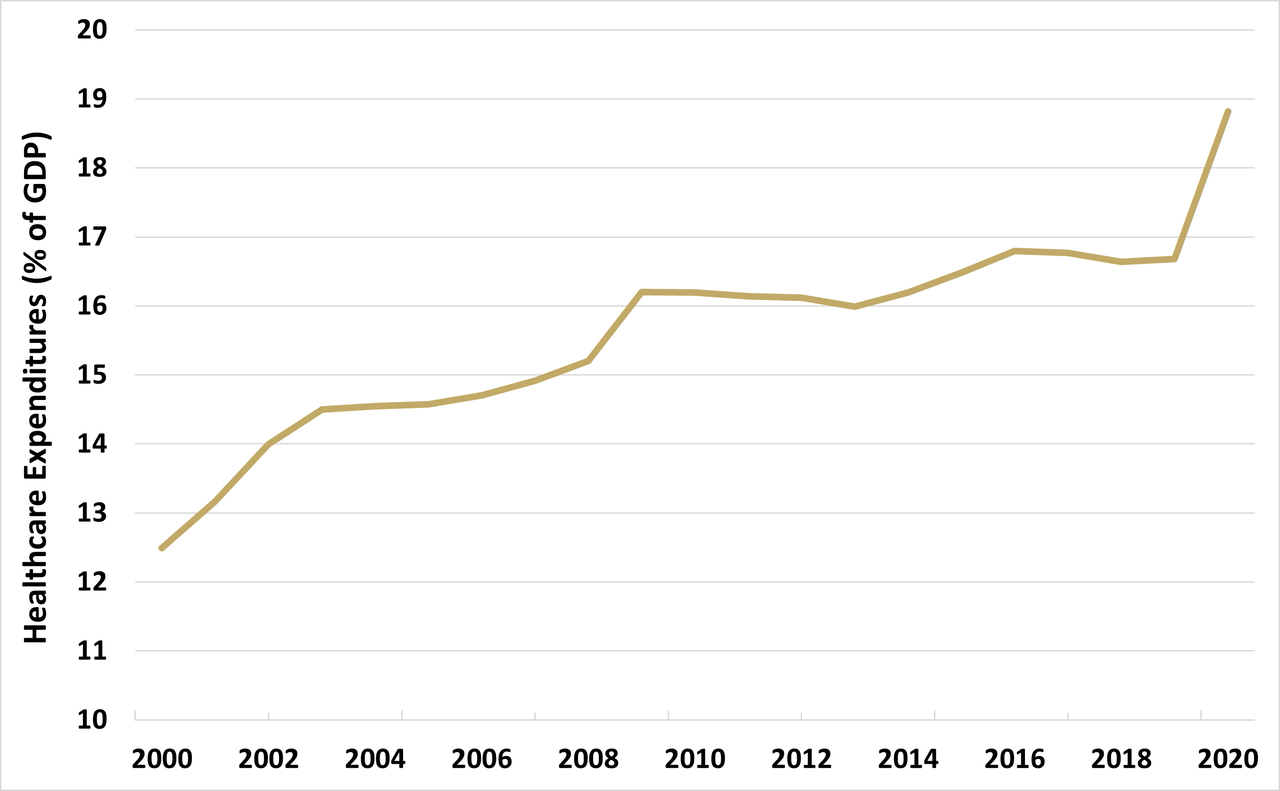
The strong upward trend in industry growth can be seen in the relative strength of healthcare stocks, as represented by the MSCI USA Health Care Index, versus the S&P 500 Index (SPX). Figure 2 shows this performance differential since the Index’s inception in 1995.
Figure 2: Health Care Stocks vs SPX, Total Return1/2/95 – 4/30/24
Source: Bloomberg Past performance is no guarantee of future results. It is not possible to invest directly in an index.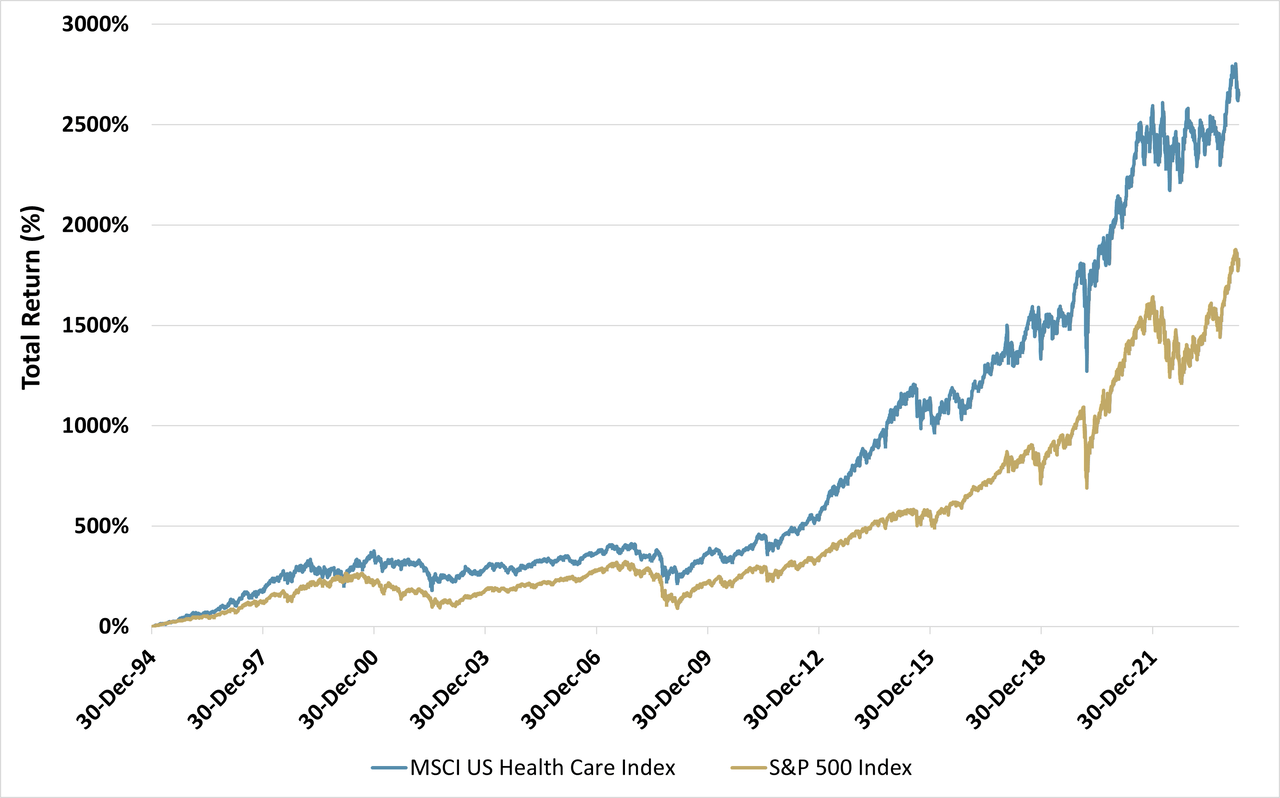
Enhancing the 60/40 Portfolio with Health Care Stocks
Traditionally, the 60/40 portfolio aims to balance the growth potential of equities with the stability of bonds. However, with the potential for an economic slowdown and pullback from all-time highs for large-cap equity indices, adding health care equities offers a strategic method to enhance portfolio diversification. Health care stocks tend to be less sensitive to economic cycles, providing stability and potential growth, even when other sectors falter. And as we showed in Figure 2, this has resulted in a strong outperformance for the broader sector. Since its 1995 inception (until April 30th, 2024), the MSCI USA Health Care Index has displayed a reduced beta of 0.75 to the S&P 500 Index (SPX) (see Figure 3).
Figure 3: Health Care Stocks vs. SPXRegression of Weekly Total Returns1/2/95 – 4/30/24
Source: Bloomberg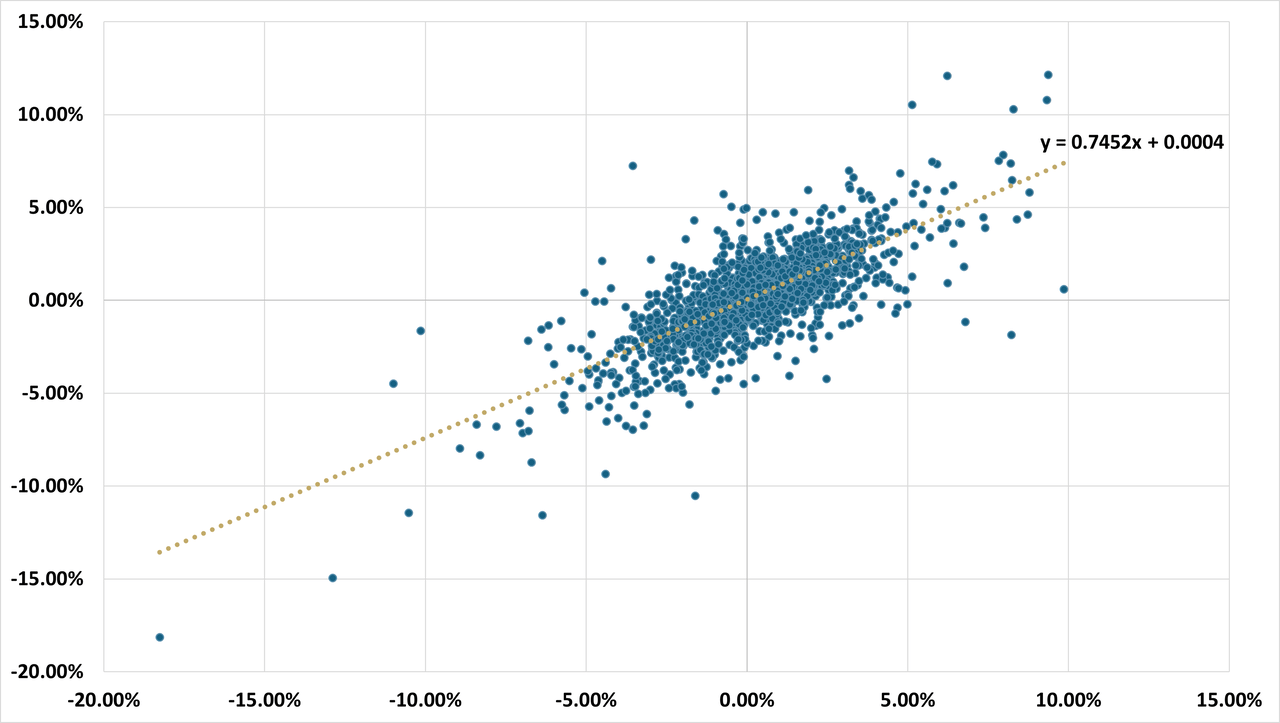
Further, health care stocks have displayed volatility profiles similar to the broad market index while benefiting from trending lower in recent years, as shown in Figure 4 below. Health care stocks also had lower maximum average drawdowns during the full assessment period – averaging ~9.6% max drawdowns when compared to SPX’s -11.44%. These characteristics make health care equities a prudent choice for investors aiming to mitigate cyclical equity risk and enhance risk-adjusted returns within the classic portfolio of stocks and bonds.
Figure 4: Health Care Stocks vs SPX, 90-Day Trailing Volatility1/2/95 – 4/30/24
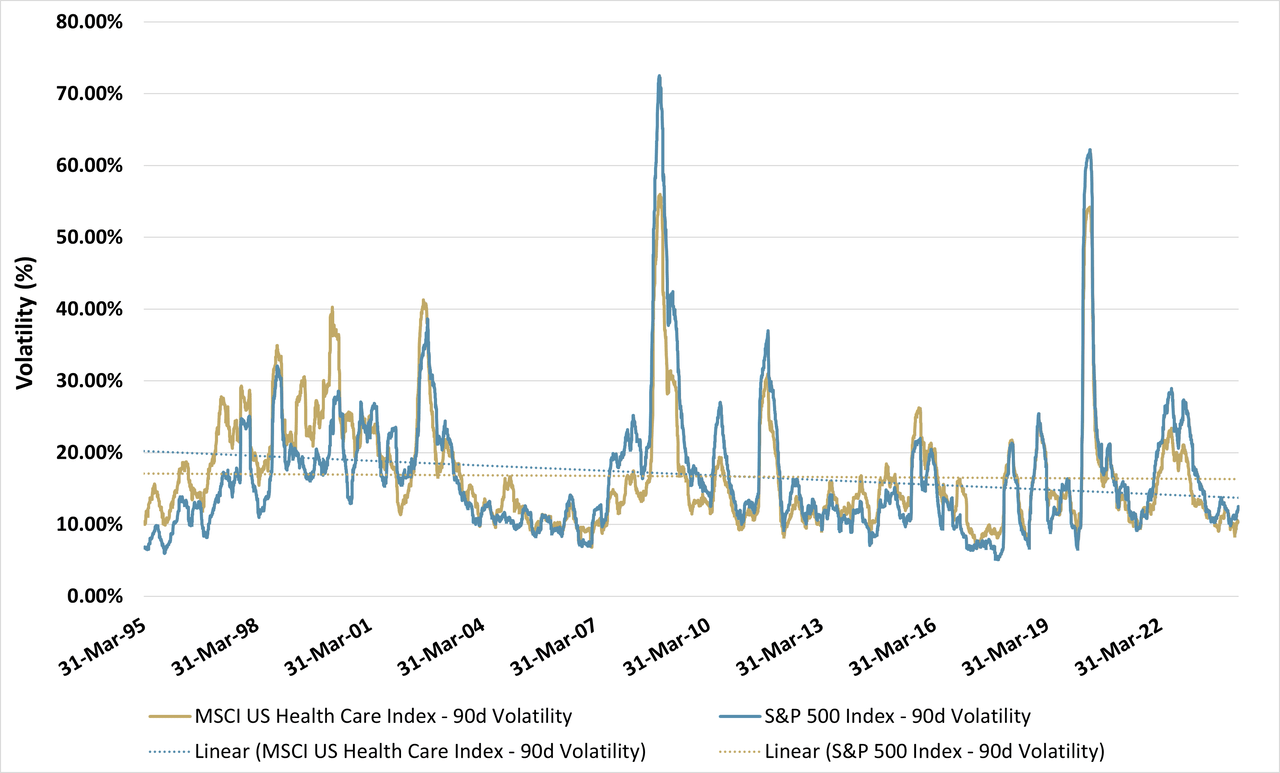
The Case for Active Management in Health Care Investing
The healthcare sector’s complexity and rapid evolution require nuanced understanding and agility that active management can provide. Active managers can navigate the intricacies of regulatory changes, patent cliffs, and rapid technological advancements, areas where passive funds might lag. By actively selecting companies at the forefront of innovation—such as biotechnology pioneers or telemedicine leaders—the Simplify Health Care ETF, PINK, led by industry-veteran portfolio manager Mike Taylor, can seek to capitalize on growth opportunities quickly and adjust portfolios in response to emerging risks.It’s also important to note that within the MSCI USA Health Care Index, 890 names have been included in the index in the last 10 years (4/30/2014 – 4/30/2024). During that time, 10 names accounted for 56% of the index’s total return. Another 498, or well over half, of the included companies negatively contributed to the overall index during their time as member constituents.When assessing the same index from 10/7/2021, PINK’s inception date, the results are even more jarring. 619 individual companies were included in the index during this time and 435 of said companies negatively contributed to the index’s total return with only a handful of names having a meaningful positive impact on the aggregate total return.With very few significant winners and very many potential losers, the opportunity for active management is high in the health care sector.
Why Consider the PINK ETF?
The PINK ETF exemplifies an active approach by concentrating on high-potential sub-sectors within health care, such as biotechnology and pharmaceuticals, which are likely to benefit from demographic trends, such as aging populations and increasing health consciousness. Moreover, the ETF structure allows for tactical adjustments that are crucial in a sector where the regulatory landscape and competitive dynamics are constantly evolving. And while selecting the right companies is important, equally important is the omission or avoidance of firms that may be facing business risks such as regulatory scrutiny, trial failure, or patent expiration.Since launching in October of 2021, PINK has outperformed its benchmark of the MSCI USA Health Care Index by over 11%, as displayed below in Figure 5.
Figure 5: PINK vs MSCI USA Health Care Index, TR10/7/21 – 4/30/24
Source: Bloomberg The performance data quoted represents past performance and is no guarantee of future results. For the current standardized performance and the most recent month-end performance, please call (855) 772-8488 or visit the Fund’s website at www.simplify.us/etfs/pink-simplify-health-care-etf.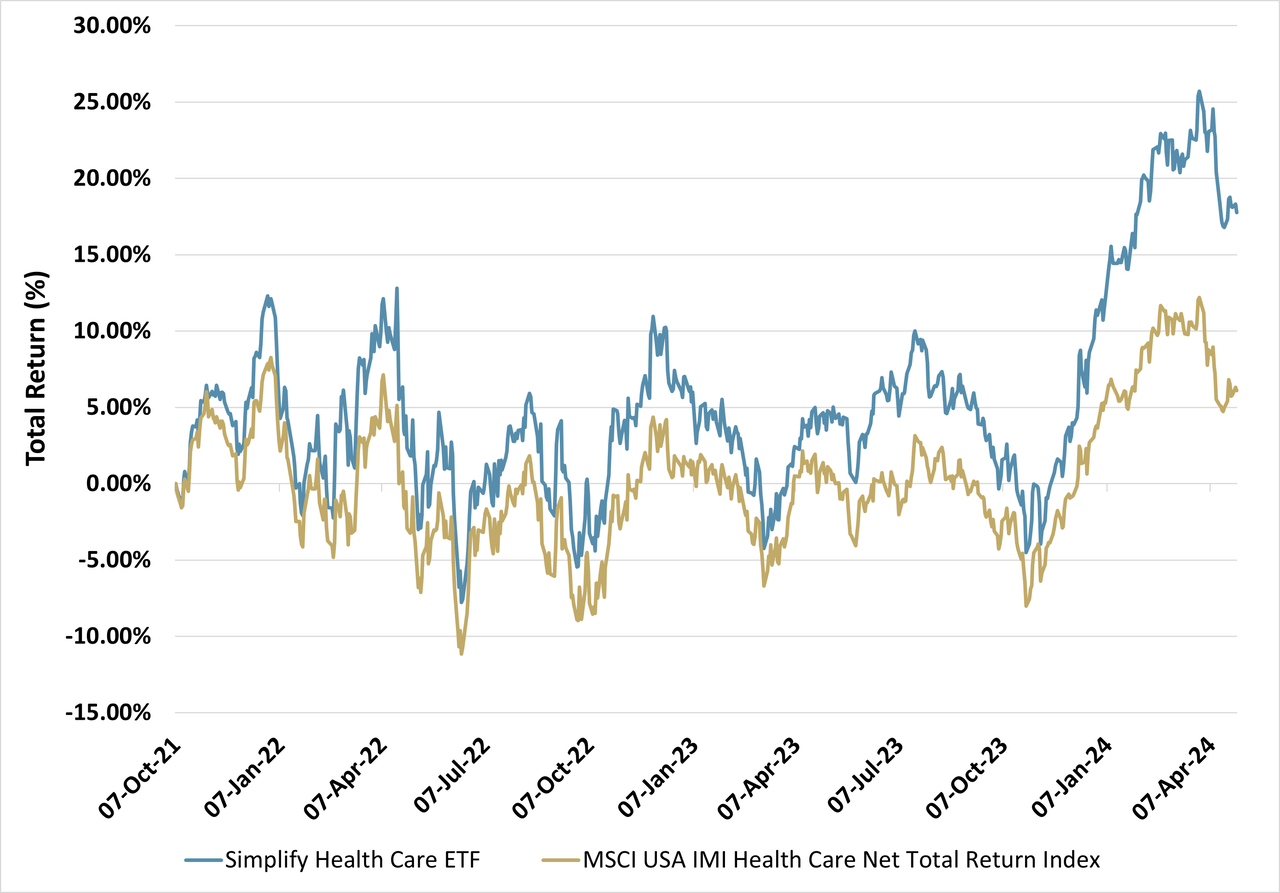
Conclusion
Incorporating an overweight position to health care in a traditional 60/40 portfolio not only diversifies risks but also introduces an element of growth potential that is hard to replicate in other sectors. The strategic use of actively managed health care funds like the Simplify Health Care ETF can potentially enhance overall portfolio performance, offering a compelling blend of stability, growth, and responsiveness to market changes. As we look to the future, the macroeconomic and strategic logic for including health care in investment portfolios becomes increasingly persuasive, ensuring that investors are well-positioned to capitalize on the sector’s dynamic opportunities.
Investors should carefully consider the investment objectives, risks, charges, and expenses of Exchange Traded Funds (ETFs) before investing. To obtain an ETF’s prospectus containing this and other important information, please call (855) 772-8488, or visit SimplifyETFs.com. Please read the prospectus carefully before you invest.An investment in the fund involves risk, including possible loss of principal. For PINK standardized performance, click here.The fund is actively-managed is subject to the risk that the strategy may not produce the intended results.The Fund focuses its investments in securities of biotechnology and the healthcare industry. Economic, legislative or regulatory developments may occur that significantly affect these industries and cause the Fund’s net asset value to fluctuate due to this concentration.The biotechnology industry can be significantly affected by patent considerations, including the termination of patent protections for products, intense competition both domestically and internationally, rapid technological change and obsolescence, government regulation and expensive insurance costs due to the risk of product liability lawsuits.In addition, the biotechnology industry is an emerging growth industry, and therefore biotechnology companies may be thinly capitalized have limited product lines, distribution channels, resources and more volatile than companies with greater capitalizations. Biotechnology companies must contend with high development costs, which may be exacerbated by the inability to raise prices to cover costs because of managed care pressure, government regulation or price controls. Companies in the pharmaceutical industry are heavily dependent on patent protection. The expiration of patents may adversely affect the profitability of the companies. Pharmaceutical companies are also subject to extensive litigation based liability and approval of the Food and Drug Administration, a process that can be long and costly. Expanding international operations may lead to risks resulting from differences between U.S. and foreign legal, political and economic systems, regulatory regimes and market practices.The Fund’s focus on the healthcare sector may cause its value to fluctuate and be more susceptible to particular risks of the sector such as extensive government regulations, restrictions on government reimbursement for medical expenses, rising costs of medical products and services, pricing pressure, an increased emphasis on outpatient services, changes in the demand for medical products and services, a limited number of products, industry innovation, changes in technologies and other market developments.Simplify ETFs are distributed by Foreside Financial Services, LLC. Simplify and Foreside are not related.
Original Post
Editor’s Note: The summary bullets for this article were chosen by Seeking Alpha editors
Credit: Source link












































